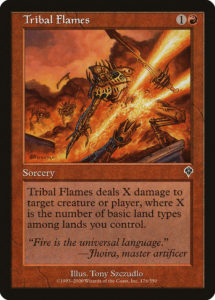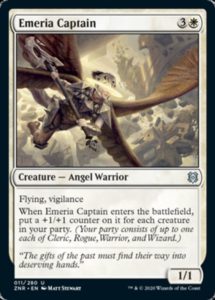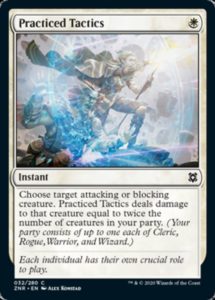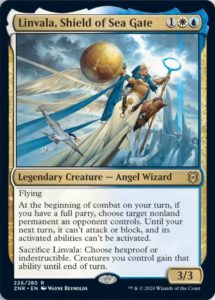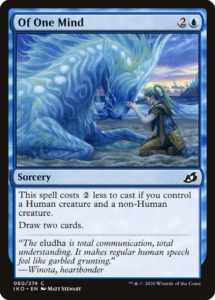Party is the second new mechanic in Zendikar Rising (last week we discussed the other one, Modular Double-Faced Cards). It’s a unique mechanic, combining the batching technology only seen in Dominaria’s Historic with the bounded scaling of Invasion’s Domain. It hearkens back to original Zendikar’s Ally theme and definition as Adventure World while also hewing closer than any other mechanic to Dungeons & Dragons (a record sure to be tested when Magic has its first crossover set with D&D next year).
Today, we’ll examine likely how the mechanic will play and how its cards ought to be evaluate in anticipation of this weekend’s digital prerelease. The first question to ask of a mechanic is how much bang you’re getting for your buck. To answer that with Party, let’s first look at its ancestor mechanic, Domain.
Rate
Domain cards have general rule of thumb: a Domain of three provides a decent deal, four or higher provides something that feels like cheating, and two or less gives you something below rate. This makes sense, since Domain is almost completely uninteractive—lands are the least interactive card type, so your opponent can’t shut off your Domain—and a Domain of two is basically a given in any deck. If Domain cards were already solid at two, they’d be desirable for everyone and would likely be far too strong at four, much less five.
Party, however, is a very different animal. Yes, it only scales to four, which reduces the ceiling of any effect; but critically, it is both costly and highly interactive. Increasing your Domain involves having ample fixing and drawing the right balance of colors, but increasing your Domain only requires playing lands (and maybe a fixing spell or two). Every increase in your Party requires you to invest mana summoning a creature, and that work is vulnerable to disruption or death in combat. Party is a much more fragile mechanic than Domain, and we should consider cards accordingly. We shall see how feasible it’ll be to achieve a full party in Limited (having four relevant creatures on the battlefield is not the most common occurrence, and oftentimes accomplishing that is sufficient to win the game on its own). But the real question is what the rule of thumb for a “good” party.
Party of One
Looking over creatures with Party, there doesn’t seem to be a consistent Party number at which they go from being okay to good to overpowered. Much of this is due to the fact that their power isn’t fully baked into their Party abilities. Shepherd of Heroes is a solid creature as a five mana flying—gaining a bit of life (and occasionally doing an Archway Angel impression) is a bonus, but not where the majority of the card lies. Emeria Captain, on the other hand, would be a disappointing common if it were always an Abbey Griffin. But give her a Cleric and a Rogue and she turns into a cheaper Serra Angel.
The trick to evaluating Party creatures lies in recognizing how much of their power relies on a Party and how good they are if they Party alone. Kabira Outrider and Cascade Seer aren’t especially exciting cards and don’t fluctuate in power terribly much, but Drana’s Silencer and Thundering Sparkmage dramatically change in power with each member of the Party.
Party of None
Spells with Party have a more difficult time than creatures. Every Party creature is happy to start the Party—though yes, your opponent can deny you their benefit by killing an Acquisitions Expert with its a ability on the stack. By comparison, Strength of Solidarity, Allied Assault, and Practiced Tactics do absolutely nothing on their own and really need fuller Parties to function.
They’re distinct from spells like Skyclave Plunder (which, like Shepherd of Heroes, derives little of its power from the Party ability) and Deadly Alliance (which is a fine spell before cost reduction comes into play). So again, there’s no consistent number as there was with Domain to aim for universally; it’s all a matter of recognizing where Party provides the icing to an already playable cake (Synchronized Spellcraft) and where Party is an essential component to to function (Ravager’s Mace).
Full House
Full Party is a novel design innovation. Having such terminology gives players an explicit quest. As game designers, we create excitement when presenting achievements (both explicit and implicit) for players to strive for—and this quest seems challenging. Just acquiring a full party is hard, keeping it is likely even harder, and there’s still the matter of whether the reward is even worth it. In Limited, getting all four creatures types shouldn’t be easy, given that each (nongreen) color is only good at providing one or two classes and completely lacks one of the four. (Green can provide all four, but only has access to a small amount of each.)
In Constructed, you’re guaranteed access to payoffs like Linvala, Shield of Sea Gate and can fill your deck out with Partygoers, but getting to four creatures invites a sweeper, and specifically getting and protecting four different creatures (none of which are named Uro,.Titan of Nature’s Warth) seems like a challenging quest that will struggle to be appropriately rewarded. That isn’t a flaw of Party’s design, but it does render the mechanic less likely to show up with force in Constructed.
In the past year, we’ve seen three new takes on tribal. Throne of Eldraine introduced negative tribal with RG non-humans-matter, Ikoria played with multi-tribe negative tribal with humans & non-humans-matter, and now Party introduces a tribal mechanic that rewards going wide on four tribes at once. It’s been interesting seeing these little innovation flow into one another and makes me wonder what other novel tweaks on a well-trodden path lie just around the bend. But more importantly, it makes me excited to try out all these new cards this weekend.
Shana tovah to those celebrating this week, and happy prerelease, everyone!
—Zachary Barash is a New York City-based game designer and the commissioner of Team Draft League. He designs for Kingdom Death: Monster, has a Game Design MFA from the NYU Game Center, and does freelance gatame design. When the stars align, he streams Magic (but the stars align way less often than he’d like).

